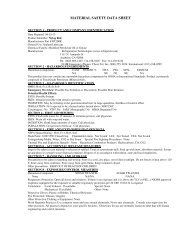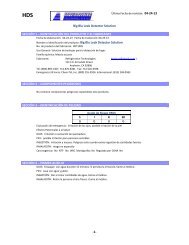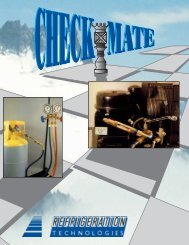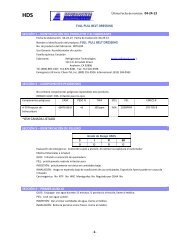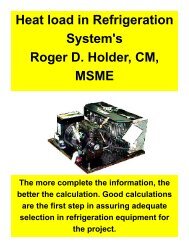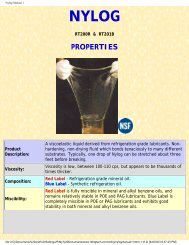Balancing of a Water and Air System (PDF
Balancing of a Water and Air System (PDF
Balancing of a Water and Air System (PDF
Create successful ePaper yourself
Turn your PDF publications into a flip-book with our unique Google optimized e-Paper software.
49<br />
<strong>and</strong> replacement should be shut <strong>of</strong>f, one-step at a time. Each combination <strong>of</strong> operation<br />
should be rechecked to ensure that design pressures <strong>and</strong> flows are maintained in each<br />
zone <strong>and</strong> between zones. This requires that the replacement airflow rate compensate<br />
automatically with each increment <strong>of</strong> exhaust. It may require some adjustments in<br />
controls or in damper linkage settings to get the correct proportional response.<br />
4. When the preceding steps are complete, the system is properly integrated <strong>and</strong><br />
balanced. At this time, all fan speeds <strong>and</strong> damper settings (at all modes <strong>of</strong> operation)<br />
should be permanently marked on the equipment <strong>and</strong> in the test <strong>and</strong> balance report. <strong>Air</strong><br />
balance records <strong>of</strong> exhaust, supply, return, fresh air, <strong>and</strong> individual register airflows<br />
must also be completed. These records should be kept by the food service facility for<br />
future reference.<br />
5. For new facilities, after two or three days in operation (no longer than a week <strong>and</strong><br />
usually before the facility opens), all belts in the system should be checked <strong>and</strong><br />
readjusted because new belts wear in quickly <strong>and</strong> could begin slipping.<br />
6. Once the facility is operational, the performance <strong>of</strong> the ventilation system should be<br />
checked to verify that the design is adequate for actual operation, particularly at<br />
maximum cooking <strong>and</strong> at outside environmental extremes. Any necessary changes<br />
should be made, <strong>and</strong> all the records should be updated to show the changes.<br />
Rechecking the air balance should not be necessary more than once every 2 years<br />
unless basic changes are made in facility operation. If there are any changes, such as<br />
adding a new type <strong>of</strong> cooking equipment or deleting exhaust connections, the system<br />
should be modified accordingly.<br />
SYSTEMS PRINCIPLES AND PROCEDURES FOR<br />
Multiple-Hood <strong>System</strong>s<br />
Kitchens exhaust systems serving more than a single hood present several design<br />
challenges not encountered with single-hood systems. One <strong>of</strong> the main challenges <strong>of</strong><br />
multiple-hood exhaust systems is air balancing. Because balancing dampers are not<br />
permitted in the exhaust ducts, the system must be balanced by design. Zoning may be<br />
desirable for a balanced design <strong>and</strong> to improve energy conservation. Hood accessories<br />
are now available to allow balancing at individual hoods. Additionally, most filters come<br />
in varying sizes to allow pressure loss equalization at varying airflows. Some hoods <strong>and</strong><br />
grease filters have adjustable baffles that allow airflow to be adjusted at the hood. These<br />
may be helpful for relatively fine balancing, but the system must provide most <strong>of</strong> the<br />
balancing. <strong>System</strong> zoning is preferred, because incorrect installation <strong>of</strong> a multi branch<br />
system can lead to complex problems. Adjustable filters should not be used when they<br />
can be interchanged between hoods or within the same hood because an interchange<br />
could disrupt the previously achieved balance. <strong>Balancing</strong> can also be accomplished by<br />
changing the number <strong>and</strong>/or size <strong>of</strong> filters.<br />
For correct flow through a branch duct in a multiple-hood system, the static pressure<br />
loss <strong>of</strong> the branch must match the static pressure loss <strong>of</strong> the common duct upstream<br />
from the point <strong>of</strong> connection. Any exhaust points subsequently added or removed must<br />
be designed to comply with the minimum velocities required by code <strong>and</strong> to maintain the<br />
49




